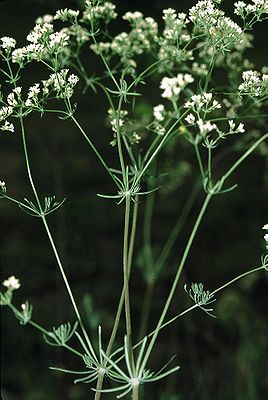Blue-green bedstraw
| Blue-green bedstraw | ||||||||||||
|---|---|---|---|---|---|---|---|---|---|---|---|---|

Blue-green bedstraw ( Galium glaucum ) |
||||||||||||
| Systematics | ||||||||||||
|
||||||||||||
| Scientific name | ||||||||||||
| Galium glaucum | ||||||||||||
| L. |
The blue-green bedstraw ( Galium glaucum ) is a species of the rubiaceae family. It is rarely found in Central Europe. Their distribution area extends from Spain to Central and Southeastern Europe .
description
The blue-green bedstraw is a perennial , herbaceous plant that usually reaches heights of 20 to 80 cm. It forms a richly branched, red rhizome as a persistence organ. The stem, which is round to slightly square in cross-section, grows upright, has few branches and is completely bare, only a few hairs are sometimes found at the base.
The leaves are eight to ten together in a whisk. The simple leaf blades are linear with a width of 1.5 to 2.5 mm, with a rounded upper end on which a short spike tip sits. The upper side of the leaf is dark green and the underside of the leaf is blue-green. The edge of the foliage is rolled back.
The blue-green bedstraw flowers mainly in the months May to July, sometimes even in September. The inflorescence is loosely trugdoldig . The approximately 2 mm long, white, more rarely reddish crown is funnel-shaped and over half of it has four columns.
The smooth fruit has a length of 2 to 2.5 mm.
The number of chromosomes is 2n = 22 or 44.
Occurrence
The blue-green bedstraw occurs from Spain to Central and Southeastern Europe. To the east it penetrates to Southwest Asia .
Galium glaucum is rare in Germany . Only in the Swabian Alb as well as in Anhalt and Thuringia is it more common. On the Swabian Alb it rises up to approx. 1000 m above sea level on the Hochberg near Deilingen . In Austria it occurs scattered in the Pannonian region , otherwise rarely. In places it is considered endangered. The blue-green bedstraw is rarely found in Switzerland.
Galium glaucum grows on limestone grasslands, on sunny slopes and in sparse bushes. It prefers dry, warm, mostly calcareous and stony loamy soils. In Central Europe it is a species of the Festuco-Brometea class, but also occurs in societies of the Geranion sanguinei association.
Subspecies
One can distinguish the following subspecies:
- Galium glaucum subsp. australe Franco : It occurs in Portugal and northwestern Spain.
- Galium glaucum subsp. glaucum : It occurs from Western and Central Europe to the Crimea .
- Galium glaucum subsp. murcicum (Boiss. & Reut.) O.Bolòs & Vigo : It occurs only in southeastern Spain.
literature
- Henning Haeupler , Thomas Muer: picture atlas of the fern and flowering plants of Germany (= the fern and flowering plants of Germany. Volume 2). Published by the Federal Agency for Nature Conservation. Ulmer, Stuttgart 2000, ISBN 3-8001-3364-4 .
- August Binz , Christian Heitz: School and excursion flora for Switzerland. Schwabe & Co., Basel 1986, ISBN 3-7965-0832-4 .
- Erich Oberdorfer : Plant-sociological excursion flora. Ulmer Verlag, Stuttgart 1990, ISBN 3-8001-3454-3 .
- Christian August Friedrich Garcke : Illustrated flora. Paul Parey Publishing House, Berlin / Hamburg 1972, ISBN 3-489-68034-0 .
Individual evidence
- ↑ a b Erich Oberdorfer : Plant-sociological excursion flora for Germany and neighboring areas . With the collaboration of Angelika Schwabe and Theo Müller. 8th, heavily revised and expanded edition. Eugen Ulmer, Stuttgart (Hohenheim) 2001, ISBN 3-8001-3131-5 , pp. 765 .
- ^ Arno Wörz: Rubiaceae. In: Oskar Sebald among others: The fern and flowering plants of Baden-Württemberg . Volume 6, Verlag Eugen Ulmer, Stuttgart 1996, ISBN 3-8001-3343-1 , p. 471.
- ↑ a b c d Rafaël Govaerts (Ed.): Galium glaucum. In: World Checklist of Selected Plant Families (WCSP) - The Board of Trustees of the Royal Botanic Gardens, Kew . Retrieved January 28, 2016.
Web links
- Galium glaucum L., blue-green bedstraw. In: FloraWeb.de.
- Blue-green bedstraw . In: BiolFlor, the database of biological-ecological characteristics of the flora of Germany.
- Galium glaucum L. In: Info Flora , the national data and information center for Swiss flora . Retrieved January 28, 2016.
- Thomas Meyer: Bedstraw data sheet with identification key and photos at Flora-de: Flora von Deutschland (old name of the website: Flowers in Swabia )


